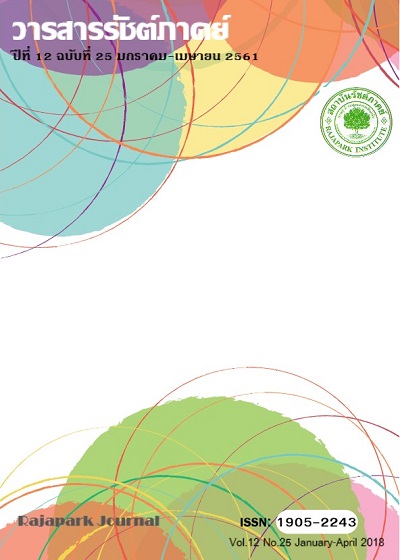Organizational engagement that affects the effectiveness of employee performance. Sunthorn Metal Industries Co., Ltd
Main Article Content
Abstract
The Research of : The relationship in the organization that affect employee’s effectiveness of SOONTHORN METAL INDUSTRIES CO., LTD, to study the relationship in the organization and effectiveness of the employee. This research is a survey research. The population are employee of SOONTHORN METAL INDUSTRIES CO., LTD. Using a Questionnaire and analyze the data by using Statistic tools such as Frequency distribution, Percentage, Standard Deviation and Test the hypothesis by Pearson’s product moment correlation and Multiple Regression Analysis The result of the research found that the overview of the opinions about the relationship between the employee and organization are in high level, average score are 4.50. If consider by each topics found that the topic that have the highest average score is the relationship, average score is 4.54. The lowest average score is about promotion of the employee, average score is 3.84.
For the effectiveness of the employee’s performance in overview is an the high level,average score is 4.50. if consider by each topic found that the highest average score is Adaptability Flexibility with the score of 4.60 and the lowest average score is about the Integration with the score of 4.33. The test of the relationship between the organization and the employee and effectiveness of employee’s performance. The research found that the relationship of the employee to the organization about basic factors, supportive of the organization and the relationship affect the effectiveness of the employee’s performance with the significance level is 0.01
Article Details
Views and opinions appearing in the Journal it is the responsibility of the author of the article, and does not constitute the view and responsibility of the editorial team.
References
อรุณ รักธรรม. (2525). หลักมนุษยสัมพันธ์กับการบริหาร. กรุงเทพฯ: ไทยวัฒนาพานิช.
Baron, R. A. (1986). Behavior in Organization. Boston: Allyn and Bacon.
Campbell,R.F.et al. (1977). “On the Nature of Organizational Effectiveness” in New purposetives on Organizational Effectiveness. Edited by Paul S. Goodman and Johannes M.Pennings and Associates.San Francisco : Jassay Bass.
Coffman, Curt W. and Gonzalez-Molina, Gabriel. (2002). Follow This Path: How the World’s Greatest Organizations Drive Growth by Unleashing Human Capital. New York: Warner Book, Inc.
Herbert J., & Arthur w. Sherman. (1976). Personal Management. Ohio : South Western Publishing Co.
Greenberg, Jeraid. and Baron, Robert A. (1993). Organizational Behavior. (4th ed.). Boston: Allyn and Bacon.
Gibson, J. L., Lvacerich, J. M., & Donnelly, J. H. (1979). Organizations: behavior structure and Process. Texas: Business.
Gibson, J. L. (2000). Organizations Behavior (7th ed.). Boston: Irwin.
Mowday, R.T., Porter, L.W. & Steer, R.M. (1982). Employee - Organizational Likage: The Psychology of Commitment Absenteeism and Turnover. New York: Academic Press
Nahavendi, A.& Malekzadeh, A.R. (1999). Organizational Behavior: The Person organizational Fit.
Steers R.M. (1977). Antecedents and outcomes of organizational commitment. Administrative Science Quarterly.
Sheldon Mary. (1971). Investment and Involvements as Mechanism ProducingCommitment to the Organization. 143 Administrative Science Quarterly

